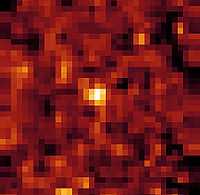(55565) 2002 AW197
|
Probable dwarf planet 2002 AW197 as taken by the Spitzer Space Telescope on 13 April 2004 | |
| Discovery[1] | |
|---|---|
| Discovered by |
Michael E. Brown, Chad Trujillo, Eleanor F. Helin, Michael Hicks, Kenneth J. Lawrence, Steven H. Pravdo Palomar Observatory (675) |
| Discovery date | January 10, 2002 |
| Designations | |
| MPC designation | (55565) 2002 AW197 |
| none | |
|
Cubewano (MPC)[2] Extended (DES)[3] | |
| Orbital characteristics | |
| Epoch December 31, 2006 (JD 2 454 100.5) | |
| Aphelion | 53.503 AU (8.0040 Tm) |
| Perihelion | 41.066 AU (6.1433 Tm) |
| 47.284 AU (7.0736 Tm) | |
| Eccentricity | 0.132 |
| 325.15 a (118761 d) | |
Average orbital speed | 4.31 km/s |
| 281.945° | |
| Inclination | 24.410° |
| 297.513° | |
| 295.307° | |
| Physical characteristics | |
| Dimensions |
768+39 |
Sidereal rotation period | 8.86 h[7] |
| Albedo |
0.117+0.04 −0.03[5] 0.17±0.03[6] |
| Temperature | ≈39–40 K |
Spectral type |
(moderately red) B−V=0.91, V−R=0.56[8] |
| 20.0 (opposition)[9][10] | |
| 3.5[7] | |
|
| |
(55565) 2002 AW197 is a classical Kuiper belt object (cubewano). Measurements with the Spitzer Space Telescope have confirmed 2002 AW197 as a probable dwarf planet, although it has not been officially classified as such by the IAU. Light-curve-amplitude analysis shows only small deviations, which suggests that 2002 AW197 is a spheroid with small albedo spots.[11] Tancredi (2010) accepts it as a dwarf planet.[12] Mike Brown's website lists it as a highly likely dwarf planet.[13]
It was discovered on January 10, 2002, by Michael E. Brown et al.[1] It is located near the Kuiper cliff.
Characteristics
Observations of thermal emissions by the Spitzer Space Telescope in 2007 give a diameter of 734+116
−108 km[5] and an albedo of 0.117+0.04
−0.03.[5] The newest estimate is 768+39
−38 km[4]
Surface
ESO analysis of spectra reveals a strong red slope and no presence of water ice[14] (in contrast to Quaoar, also red) suggesting organic material (see comparison of colours and typical composition inferred from spectra of the TNOs).
Distance
As of 2013, it is currently 46.0 AU from the Sun.[9] It will come to perihelion around 2078.[7]
References
- ↑ 1.0 1.1 Marsden, Brian G. (2002-07-20). "MPEC 2002-O30 : 2002 AW197". IAU Minor Planet Center. Harvard-Smithsonian Center for Astrophysics. Retrieved 2010-01-06.
- ↑ "MPEC 2009-R09 :Distant Minor Planets (2009 SEPT. 16.0 TT)". IAU Minor Planet Center. 2009-09-04. Retrieved 2009-10-04.
- ↑ Marc W. Buie. "Orbit Fit and Astrometric record for 55565" (2009-03-23 using 112 observations). SwRI (Space Science Department). Retrieved 2009-10-04.
- ↑ 4.0 4.1 TNOs are Cool: A survey of the trans-Neptunian region. X. Analysis of classical Kuiper belt objects from Herschel* and Spitzer observations p. 18
- ↑ 5.0 5.1 5.2 5.3 John Stansberry, Will Grundy, Mike Brown, Dale Cruikshank, John Spencer, David Trilling, Jean-Luc Margot (2007). "Physical Properties of Kuiper Belt and Centaur Objects: Constraints from Spitzer Space Telescope". arXiv:astro-ph/0702538 [astro-ph].
- ↑ 6.0 6.1 Cruikshank, Dale P.; Stansberry, John A.; Emery, Joshua P. et al. (2005). "The High-Albedo Kuiper Belt Object (55565) 2002 AW197". The Astrophysical Journal 624 (1): L53–L56. Bibcode:2005ApJ...624L..53C. doi:10.1086/430420.
- ↑ 7.0 7.1 7.2 "JPL Small-Body Database Browser: 55565 (2002 AW197)" (2005-01-16 last obs). Retrieved 2008-06-28.
- ↑ Tegler, Stephen C. (2007-02-01). "Kuiper Belt Object Magnitudes and Surface Colors". Retrieved 2009-12-30.
- ↑ 9.0 9.1 "AstDys (55565) 2002AW197 Ephemerides". Department of Mathematics, University of Pisa, Italy. Retrieved 2013-12-14.
- ↑ "HORIZONS Web-Interface". JPL Solar System Dynamics. Retrieved 2008-07-02.
- ↑ Tancredi, G., & Favre, S. (2008) Which are the dwarfs in the Solar System?. Depto. Astronomía, Fac. Ciencias, Montevideo, Uruguay; Observatorio Astronómico Los Molinos, MEC, Uruguay. Retrieved 10-08-2011
- ↑ Tancredi, G. (2010). "Physical and dynamical characteristics of icy "dwarf planets" (plutoids)". Icy Bodies of the Solar System: Proceedings IAU Symposium No. 263, 2009.
- ↑ Michael E. Brown. "How many dwarf planets are there in the outer solar system? (updates daily)". California Institute of Technology. Retrieved 2011-08-25.
- ↑ D. Ragozzine; M. E. Brown (2007). "Candidate Members and Age Estimate of the Family of Kuiper Belt Object 2003 EL61". The Astronomical Journal 134 (6): 2160–2167. arXiv:0709.0328. Bibcode:2007AJ....134.2160R. doi:10.1086/522334. Retrieved 2009-12-05.
- Cruikshank, D., et al. High Albedo KBO (55565)2002 AW197, The Astronomical Journal Letters, 624,53 (May 2004). Abstract
- Doressoundiram, A.; Barucci, M. A.; Tozzi, G. P.; Poulet, F.; Boehnhardt, H.; de Bergh, C.; Peixinho, N. Spectral characteristics and modeling of the trans-neptunian object (55565) 2002 AW197 and the Centaurs (55576) 2002 GB10 and (83982) 2002 GO9: ESO Large Program on TNOs and Centaurs. Planetary and Space Science, 53, Issue 14-15, p. 1501–1509 (2005). Abstract
External links
| Wikimedia Commons has media related to (55565) 2002 AW197. |
- AstDys orbital elements
- Orbital simulation from JPL (Java) / Horizons Ephemeris
| ||||||
| ||||||||||||||
| ||||||||||||||||||||||
| ||||||||||||||||||||||||||||
